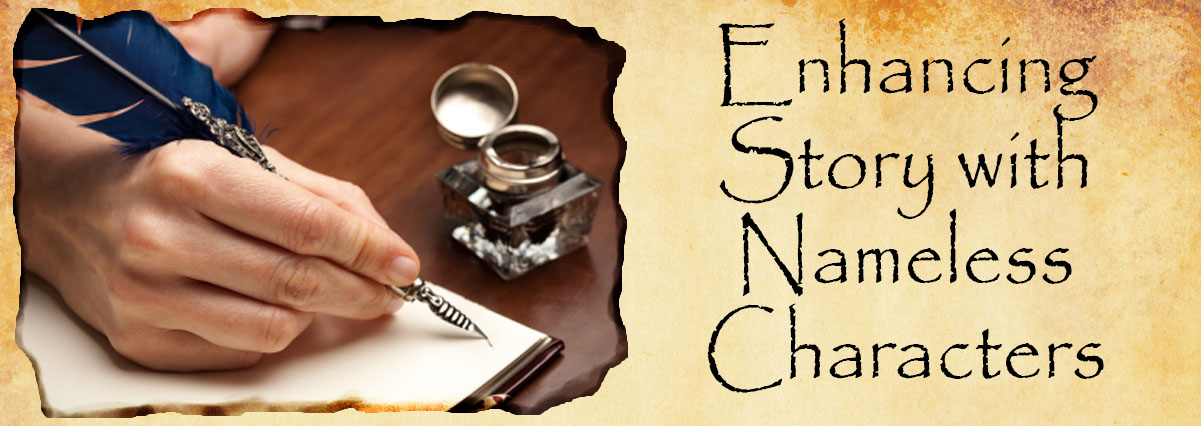How nameless characters enhance story

Nameless characters. They may seem useless to the writer and to the reader but in many respects they are key to enhancing a great fiction story. Consider how many nameless characters populate the books you read and the movies you watch. Nameless characters play well into plot development and world building.
When I am writing a story I take into consideration the environment I am throwing my main characters into. What are the sights, the sounds, the smells. I want to engage the senses so that the reader experiences the story in a profound way. But a great part of creating the environment is the establishment of nameless characters.
Let’s use the example of John, a character who is feeling lost. If you want to convey that John is starting to feel panicky you could throw in a nameless character. Crowds are milling about, heading down the busy sidewalks. Someone bumps into John. He reaches down and finds his wallet is now missing. He franticly searches the sea of faces for the pickpocket but instead his gaze is arrested by a pretty face. She stands a short distance off, smiles, then disappears in the throng moving around him. Someone steps on his foot, mutters an apology, and several other people jostle him. A pistol presses against his back.
In this short example the only characters able to affect John are nameless ones. The advantage of this is that the reader now does not feel the need to know these other characters. Instead they want to know how John is going to react to these nameless characters and the situation in general. The nameless characters have revealed a deeper level to the story and left the mind imagining what could be the motives and purposes of these nameless characters. All the while, John remains the focus.
Nameless characters add mystery and, when written well, they will enhance the traits of the main characters by causing them to react to different circumstances. While it is true that you can effect much of the same with named characters, nameless characters provide less distraction to the reader, thus allowing more focus on moments of suspense and interior dilemma.
A story is incomplete without nameless characters. In my novels I greatly enjoy creating background characters who are not assigned names. Why? Because later I can return to those characters, perhaps fleshing out their own unique stories for later projects. For example, when writing a series of fantasy novels a nameless character might be the bartender or the stable hand. Later in the series I can revisit the character, assign them a name, give them a more significant part in the series’ plot, and reference back to that moment in the story when they were nameless. To the reader it seems as if the author knew all of these facts about the nameless character all along. But truly it is often not the case.
The author might make reference to how the story’s hero/heroine glimpsed something happening to a common soldier during a battle. Then at a later point you reference back to that and make a new and insignificant background character come to life by relationally tying them to the original nameless character. Their deed then matters to the reader on an emotional level.
As you see, there are many uses for nameless characters in fiction.
Q: What sorts of nameless characters to you find interesting in fiction?

Hi Scott,
Enjoyed your article here. How about a nameless character used in a children’s story? How would you say using this device in a children’s story benefit younger readers? I hope I’ve been teaching this correctly. My teaching and demonstration so far in using this technique is to show an author’s way of getting her readers to place themselves in the character’s position (my website is under construction). Because we all share some humanistic patterned behavior (if there’s such a description), my character’s purpose serves to mock the typical behavior in most children. One example might be when they pitch a fit because they have to share their afterschool snack with a younger sibling.
Hi Judith,
I am glad you enjoyed the article.
Yes, you can use a nameless character to help the child put themselves in that character’s shoes. However, it is not necessary for the child to follow a nameless character in order to understand and learn the lessons that character learns in the story journey.
I’m a little unclear as to the premise of your story and what you are looking to achieve with it. Did you mean “make light of typical behavior” or did you really mean “mock?” Mocking always has a negative impact and I would not recommend that in teaching children strong character. We learn best by following the examples of those who are doing morally better than ourselves, not if they put us down.
A nameless character can be effective in a children’s story in this way: a hero or heroine overcomes obstacles, thus proving their fortitude in the face of great odds, and the child thinks “Ah! I want to be like him, not like those he had to overcome.”
The character’s name can be introduced at a later point in the story in this scenario, because the child learns from the story and then finds out (for example) Now this is the great Odysseus.
A child should learn that pitching a fit because they have to share with their younger sibling is a shameful behavior and a sin. A sin against themselves, their sibling, and their Creator. A story of that nature is most effective when it shows children the negative consequences of behaving that way.
I hope this makes sense. It’s always fun to spitball writing theory!